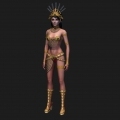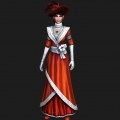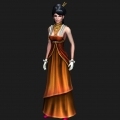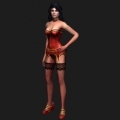Hal Barwood
Finite Arts
First posted on 04 January 2009. Last updated on 06 April 2012.

|
| Hal Barwood, the lead designer of Mata Hari, is a LucasArts alumni who now works as a freelance contractor at Finite Arts. |

|

|

|

|

|
All images are courtesy of Hal Barwood, Finite Arts and Class Wolter, dtp entertainment AG © 2008.
Currently, the adventure game genre is seeing a lot of spectacular comebacks. Among those fames is Hal Barwood, who is making a return to the genre with his first bona fide adventure game since Indiana Jones and The Fate of Atlantis. The well-known LucasArts alumni and now freelance contractor with his own company Finite Arts, who in 1999 was named among the top 25 American game designers by PC Gamer, is again collaborating with his longtime colleague Noah Falstain on a historical fiction adventure game based on the escapades of the legendary female adventurer and spy, Mata Hari. This new game, aptly titled Mata Hari, is to be developed by German developer Cranberry Productions and published by dtp Entertainment. The game promises exceptional gameplay with all the charms and skills of the famous courtesan and dancer turned spy and a story filled with political intrigue, seduction, and deception. With the Belle Époque's charged climate and the shadow of World War I looming on the horizon, Mata Hari's adventure is surely to be both an intriguing and a meaningful experience.
Recently, we have been granted an interview with the game's designer Hal Barwood. We ask him about the historical inspirations of Mata Hari, the motivations driving the game's heroine, and the game's unique mechanics that include a more advanced and streamlined point-and-click interface. We also ask about his general ideas how to design an adventure game, his thoughts on the new Indiana Jones movie, and his other unusual projects that reflect the extent of his passion for game design. His in-depth responses give a good sense of the game designer's profundity of experience and developed sensitivity as a storyteller.
Check out our exclusive gallery of previously unpublished concept art from Mata Hari!
- There is a discrepancy between the popular culture image of Mata Hari and the real historical persona, who is usually described as a dilettantish spy confused about her allegiances.
How is Mata Hari portrayed in the game?
- Mata Hari, born Margaretha Zelle in the Netherlands, was a real person. In popular culture, she is seen as a romantic figure -- a sexy dancer who used her fame and womanly charms to steal state secrets during World War I. We did a lot of research, and most sources agree that ebbing fortunes induced her to spy for money. I suppose she thought her skills as a seductress would overcome all obstacles, but espionage is a dangerous game. She was naive, she made mistakes, she got caught. Not much fun there. So we decided the player should have a chance to fulfill the promise of her legend -- to guide her to triumph as a perfect secret agent.
- What are her deeper goals and motivations in the story?
- She has at least three: 1. an idealistic belief that her spying will forestall a war; 2. a desire to extricate herself from her situation as the dangers, complexities, and personal compromises mount up; and 3. well -- money.
- You are fond of mixing historical facts into your storytelling for an added sense of authenticity.
How does this work for Mata Hari?
- It works for any character, I think. In Mata's case, she was real, so it's more mixing fiction into reality than the other way around. We took the position that history portrays Mata as an unlucky spy because she was so good that her real activities never came to light. We imagine a career that started early and continued for 10 years, with no one the wiser.
- How is the Belle Époque period being explored in the story?
- Impossible hats and long dresses. Cobblestone streets. Antique social conventions. Emerging technology. A prideful lust for war. Most important, however, we bring Mata into contact with famous and important people of the times that she might well have known: historical figures like Marie Curie, for example.
- Other than Mata Hari, what are the major historical and fictitious characters in the game?
- This is all taking place a hundred years ago, so names have faded into the history books. Marie Curie is probably an exception; everyone has heard of her. Fritz Haber invented an industrial process to fix nitrogen. Billions of people today get enough to eat because of fertilizers derived from that invention, but most of us have never heard of the guy. The others are obscure people that figured in Mata's life: Gabriel Astruc, her dance manager; Georges Ladoux, a French counter-intelligence officer; Elsbeth Schragmuller, possibly a real spy; Arnold von Kalle, a German intelligence officer.
- What are the relationships between them?
- Well, they only connect through Mata.
- How fun it is to use famous historical figures as main characters in the game and their biographies as basis for the storylines?
- It's great fun. I must say, we twist those biographies quite a bit without the slightest blush of shame -- fiction trumps reality!
- The gameplay in Mata Hari is quite unique and innovative for an adventure game. For example, some of the game's puzzles are in the form of mini-games that will never play exactly the same twice.
From your perspective, what elements of the gameplay are the most interesting and different for the player?
- Yes, well, minigames are found in many modern adventure games, but we came up with some unusual ones: secret message decoders and railroad travel, for example.
- Mata Hari's interface introduces a token system that is used to streamline and unify conversations, item usage, and choices of actions. What has inspired you to create this kind of newer, more direct game language?
- Frustration. We love adventure games, but play has often seemed clumsy to me. We wanted to advance the point-and-click form. Mata Hari is a first pass, and we didn't achieve every goal; some of the older mechanics are still apparent.
- What makes this system superior to the traditional interfaces used in past adventure games?
- It streamlines play; it keeps dialog fresh; we think it's more fun.
- What is the extent of your collaboration with Noah Falstein on Mata Hari?
- We worked closely together for months on the story and design, and then I wrote the dialog -- in English yet, even though the first market is Germany. So everything was then translated back into German by Ziggy Fielder.
- How has this experience differed from your previous collaboration with him on Indiana Jones and the Fate of Atlantis?
- They were similar experiences. The main difference, I think, is that Noah was ushering me into the world of professional game development back when we did Fate, and this time we've both been working in the business for many years. That means a lot of the ideas that go back and forth do so in a kind of old-friend shorthand.
- You are best known for your work in the sci-fi, historical, and fantasy genres. Which of these genres of fiction do you prefer most?
- I don't have a preference for genre, but I do have a preference for type -- melodrama over comedy, say. I play games that are funny, but I could never write one. I prefer the sense of unapologetic immersion into a serious fictional experience, interactive or otherwise.
- Are there any other genres that you like to explore in the future?
- I'm also interested in making gamey games that have little narrative framework: structural challenges presented in casual game format. You'll see a little bit of this in the Mata Hari minigames.
- What do you think about the recent revival of the Indiana Jones movie franchise?
- I love it. I hope George and Steve will keep it going.
- Is it true that the initial concepts for Indiana Jones and the Infernal Machine have once originated from some loose ideas for a fourth Indiana Jones movie?
- Nope. Independently of George, I got interested in propelling Indy into the cold war environment of the 1950s with Russians as antagonists and flying saucers as the prize. George vetoed the idea, reserving UFOs for what was to become Crystal Skull. I kept the cold war, but veered away to Babylon for the prize.
- Many of your former LucasArts colleagues have since ventured out on their own and are now developing new adventure games (such as the new Sam & Max series, Insecticide, A Vampyre Story) under their own labels.
Do you play or intend to play some of these games yourself? If so, what do you think of them?
- I like the new episodic Sam 'n' Max, but I haven't played any of the others yet.
- Have you kept in personal contact with any LucasArts alumni since leaving the company?
- Oh sure. Quite a few. I live in Portland, Oregon now, so my California friends are e-mail correspondents.
- You have publicly stated that, in your opinion, exploration of a game world is not a natural part of adventure games.
In what way do you see adventure games are limited in that regard?
- Did I say that? Hmm -- well, of all game genres, adventures are the most tied to a story. While playing an adventure game, you're not as much in a world as in a plot. I guess that's what I meant.
- How do you see the bond between the player and the game world be best developed in an adventure game?
- Ideally, the player should be able to lose, so the adventure becomes a real contest, an actual game. And wouldn't it be nice if all adventure games had more than one path through? But I think that the close connection between game and story works well for adventure games, where players get gripped by the interactivity required to advance the plot.
- Game designers often prefer more abstract in-game reality and visual style over realistic simulation to allow more creativity in their game design.
How do see the visual art in Indiana Jones and the Fate of Atlantis fit into this debate? By comparison, do the more realistic visuals of Mata Hari allow for less design flexibility than the pixelated artworks of Indiana Jones and the Fate of Atlantis?
- Compared to the sumptuous renderings of Mata Hari the visual style of Fate is crude, that's for sure. But that was necessity. Fate was the first LucasArts game to use as many as 256 colors, for God's sake. We were severely limited by that era's PC performance. On the other hand, we could spend our budget on the hours necessary to build the structure for a long and complex experience. Mata Hari used a lot of its limited budget on the art, so the game is simpler.
- Arcade, strategy, or puzzle games can offer a large amount of gameplay time while relying on only a few core game mechanics. Adventure games, on the other hand, usually create only one-time challenges that have little replay values and rely heavily on the structure of strictly predetermined storylines. Is this a strength or weakness?
- I like both, so for me it's like choosing dinner from the menu at a nice restaurant: what will it be, the chicken marsala or the pasta primavera? Both are appetizing, depending on mood. (Small note: I built a couple of action-adventure games designed from the beginning as replayable story games. They were casual games before that became a recognized form. Check out Yoda Stories.)
- How do you compare between these different approaches in creating obstacles in a game?
- Until we can create characters whose personalities and dialog emerge from advanced AI techniques, under the surface everything in a game is hard-wired. Adventure games, with their one-time puzzle gates, are the most limiting, but they afford the greatest depth in storytelling for that very reason. I like to trade back and forth -- some of the games I've worked on are tightly-woven interactive stories, and some are much looser, less coherently organized slugfests.
- You have stated that an important goal when creating a game is to achieve the so-called "flow" -- a kind of unhindered, perpetual state of happiness or engrossment for the player to experience.
- I did? Okay. Flow is nice.
- In your opinion, what are examples of game titles that best exemplify this goal?
- Well, picking examples is perilous: different players will experience the flow state under different conditions. I know people who stayed up all night to work through Fate, and other people who lost track of time playing Heavenly Sword.
- How different is it to create this "flow" in adventure games as compared to games in other genres?
- I think achieving flow in an adventure game is extraordinarily difficult: solving puzzles always means starts and stops, hiccups, frustration. On the other hand, because adventure games afford good fiction, somehow players stay involved.
- You are collaborating with Noah Falstein on The 400 Project. Its goal is to compile a compendium of different informal rules of thumb for game design from professional game designers.
Which of these rules do you consider to be the most surprising in its effects on gameplay? Which are the most fruitful rules to experiment with? Are there any rules of thumb which you specifically keep in mind when designing an adventure game?
- Wow, I don't know how to answer this. Forgive me, but we've got a lot of rules, they all have an effect, they all can be bent and twisted and ignored, and I keep as many as possible in mind whenever I'm working. I guess a good way to summarize is this: don't be boring, don't punish the player, issue clear goals, cook up a variety of challenges, maximize the expressivity of everything, stir thoroughly, sprinkle boss monsters on top.
- In your spare time, you like to develop small game projects entirely by yourself and for your own amusement. Do you make them solely to entertain a game designer's joy of designing or is this a deliberate opportunity to experiment with the fundamentals of game design?
- Yes, one-man games! I love working on them. For lots of reasons, including both you mention. I find nothing humbles me more than tackling a simple little Xmas-card game and discovering a dozen hidden design challenges I've overlooked.
- What is an example of game projects of this kind?
- Snocruzer; Tumble Tiles. Several others I'm still working on.